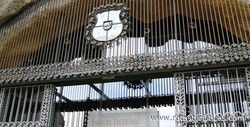




The Cave Church, located inside Gellért Hill, isn't your typical church with high ceilings and gilded interior. It has a unique setting inside a natural cave system formed by thermal springs. The cave, called Saint Ivan’s Cave (Szent Iván-barlang) after a hermit who lived there and healed people, belongs to the Hungarian Paulite order. With such a historic feel no one would think that the church and the adjacent monastery was built less than 100 years ago.
The church was founded in 1926, by a group of Pauline monks after a pilgrimage to Lourdes, France. Originally, the altar was located at the entrance of the cave and the congregation was seated outdoors on the terrace. This is why Cave Church is called Sziklatemplom ('Rock Church' or 'Church by the Rock') in Hungarian. Expansion of the cave and structural reinforcement followed throughout the 1930s. The monastery was also built around this time. During World War II, the church served as a hospital and asylum. After WWII, the monks were arrested and their superior, father Ferenc Vezér, was sentenced to death by the new Communist regime. In 1951, the church entrance was completely sealed with a thick concrete wall. A part of the wall can still be seen by the entrance.
Cave Church reopened in 1991. The church was restored and given back to the Pauline monks and it continues to serve as a church today. Service is held three times a day. The chambers of the church are one of Budapest's most unique attractions. In the little square in front of the cave there's a modern statue of St. Stephen holding a church. There are also beautiful panoramic views of Liberty Bridge.
Getting to Cave Church: The entrance to Cave Church is located near the Buda end of Liberty Bridge, across from the famous Gellért Baths. The large cross above the entrance can be seen from far away. Take streetcars 18, 19, 47 or 49 to Szent Gellért tér.
The church was founded in 1926, by a group of Pauline monks after a pilgrimage to Lourdes, France. Originally, the altar was located at the entrance of the cave and the congregation was seated outdoors on the terrace. This is why Cave Church is called Sziklatemplom ('Rock Church' or 'Church by the Rock') in Hungarian. Expansion of the cave and structural reinforcement followed throughout the 1930s. The monastery was also built around this time. During World War II, the church served as a hospital and asylum. After WWII, the monks were arrested and their superior, father Ferenc Vezér, was sentenced to death by the new Communist regime. In 1951, the church entrance was completely sealed with a thick concrete wall. A part of the wall can still be seen by the entrance.
Cave Church reopened in 1991. The church was restored and given back to the Pauline monks and it continues to serve as a church today. Service is held three times a day. The chambers of the church are one of Budapest's most unique attractions. In the little square in front of the cave there's a modern statue of St. Stephen holding a church. There are also beautiful panoramic views of Liberty Bridge.
Getting to Cave Church: The entrance to Cave Church is located near the Buda end of Liberty Bridge, across from the famous Gellért Baths. The large cross above the entrance can be seen from far away. Take streetcars 18, 19, 47 or 49 to Szent Gellért tér.
| Partagé par: Cristina Nascimento | Pas encore de commentaires |
| Vues: 8936 | |
Partagez les lieux d´intérêt à visiter, les lieux que vous avez visités lors de vos vacances, ou les endroits dans votre ville que vous souhaitez promouvoir.
Coordonnées GPS
Lat : 47.48480636706402 - Lon : 19.05208412076263
N47° 29' 5.302921430472 " E19° 3' 7.502834745468"
Commentaires
Pas encore de commentaires pour
Eglise de la grotte (Budapest)
Si Vous connaissez Eglise de la grotte (Budapest) Laissez votre commentaire
Eglise de la grotte (Budapest)
Si Vous connaissez Eglise de la grotte (Budapest) Laissez votre commentaire
MERCI

